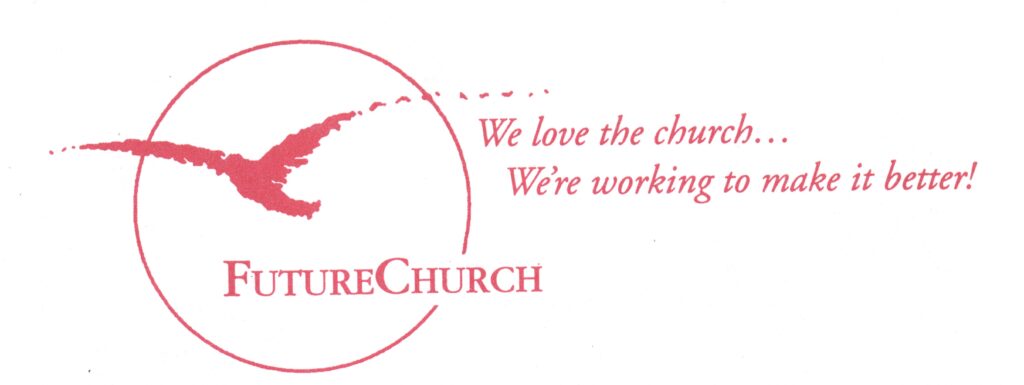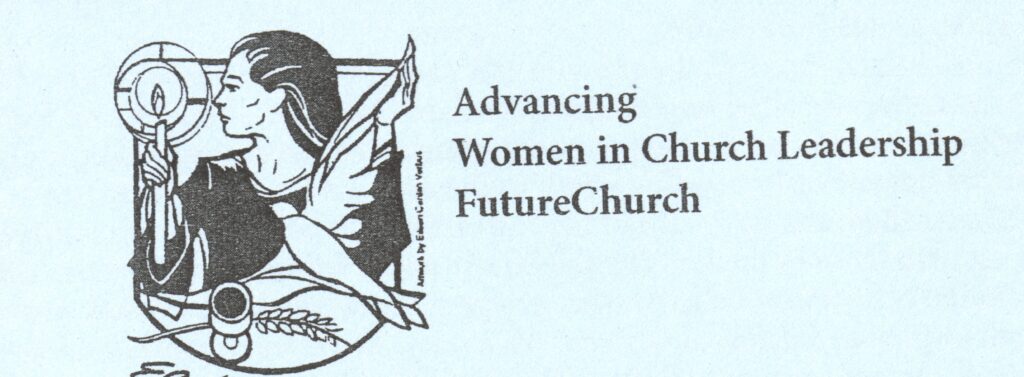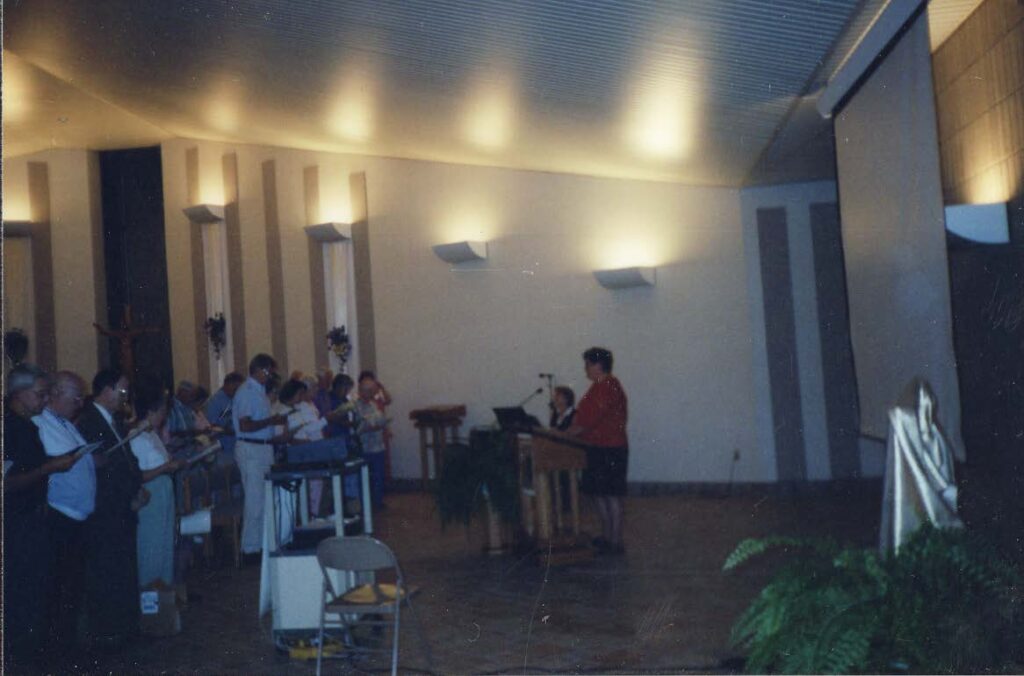Allowing both women and married men to become priests is integral to FutureChurch’s mission. FutureChurch started in the 1990s to provide a solution for the shortage of priests in the Catholic Church and argues that opening the priesthood for more individuals who feel called to the priesthood would aid this shortage. A growth in inclusion and layperson involvement in the Church is another important goal of the organization. FutureChurch seeks “changes that will provide all Roman Catholics the opportunity to participate fully in Church life, ministry, and governance”1. Looking through FutureChurch’s records in the Women and Leadership Archives, one can find resources and programs created by FutureChurch in the 1990s through the 2000s to reach Catholics and form community.

One of the main goals of FutureChurch is to increase women’s roles in the Catholic Church in all levels of leadership. In 1996 FutureChurch compiled a resource titled “Benchmarks for Church Leadership Roles for Women from the Leadership Conference of Women Religious” describing the Leadership Conference on Women Religious (LCWR) and their recommendations for the promotion of church leadership roles for women. The Leadership Conference on Women Religious is composed of leaders of active orders of Catholic nuns throughout the United States, and at the time it represented more than 83,500 women and 94% of the country’s nuns2. In November of 1994 the U.S. bishops published “Strengthening the Bonds of Peace”. In it they invited dialogue about women’s roles in the church to “look at alternative ways in which women can exercise leadership in the church”3. Responding to the invitation, the LCWR published “Creating a Home, Benchmarks for Church Leadership Roles for Women” in 1996 and included their benchmarks for measuring Church efforts to make leadership roles more available to women.
These benchmarks included recruiting and appointing women to significant leadership positions, engaging women in seminary education, and promoting the participation of women in public ministry of the local church and recording this progress. Part of this employment of women included benchmarks measuring the protections all employees receive. Examples of protection were just compensation, benefits, and advocates for employees. The benchmarks also illustrated the importance of providing reasoning for women having these leadership roles today. One benchmark is that studying the history of women in the U.S. church and the theological foundations for the equality of women should be included at every level of Catholic education.

The history of women’s involvement in the Catholic Church is an essential part of FutureChurch’s efforts to expand women’s leadership today. One pamphlet created by FutureChurch is entitled “Catholic Women Who Changed the World”. The pamphlet lists “she-ros”4 and information about their lives, starting in 183 AD through the 1990s. The pamphlet emphasizes the importance of these women and that “they are only a few voices from the great chorus of Catholic women who have changed their world and ours with their selfless grace, vast learning, inclusive fellowship and abiding faith”5. The earliest example is Perpetua, who lived circa 183-203 AD. The pamphlet details that she was a noblewoman by birth and was arrested for being a Christian. While in prison she spoke up for fair treatment for her fellow prisoners and wrote about her imprisonment before she was martyred. One of the more recent women they highlight is Thea Bowman who lived from 1937-1990. She was an African American sister and sang, preached, lectured, and taught, challenging the American church to embrace its diversity.
Another pamphlet, “The Women in Paul’s Ministry” provides information on women who took part in the formation of the Catholic Church. The pamphlet writes, “They were workers alongside their male counterparts and sharers in the ministry of communicating the gospel in whatever ways possible”6. Two women are mentioned in Paul’s letter to the Philippians, who were likely women leaders in the church, Euodia and Syntyche. This letter is part of the eleventh book “Letter of Paul to The Philippians” in the New Testament in the Christian Bible. This book is a collection of the correspondence between Paul, one of the followers of Jesus Christ and an early leader in the Church, and the congregation in Philippi, which was a major Greek city7. Paul writes to Eudio and Syntyche urging them to dissolve their disagreement, which is either with Paul or between each other, and be united in their work of evangelization. In the opening lines of his letter Paul greets the episkopoi in Philipi. This word is the origin of the word “bishop”, but at the time referenced hosts of groups of believers who met in their houses and were members of a local council of leaders. Therefore, the FutureChurch pamphlet asserts that these women were major figures in the Philippian Church.

These education materials, providing information about the current and historical involvement of women in the Catholic Church, were integral in FutureChurch’s efforts to open the priesthood. FutureChurch also put together various programs to encourage community involvement, especially women and laypeople. One example is “Women and the Word: Bridging the Gap”. The goal of “Women and the Word” was, “to raise awareness about the invisibility of women’s biblical leadership and experience in Church preaching and scripture proclamation”8. The program developed strategies for retrieving the historical memory of biblical women. During the workshop presenters discussed their scholarship about Women and the Word in the Christian scriptures. Through these presentations, question and answer sessions, and discussions they hoped to identify issues contributing to the invisibility of women’s biblical leadership and overcome obstacles to achieve gender-balanced communication of the Church’s teachings and the Bible. In 2006 FutureChurch provided a pamphlet to celebrate the feast of Saint Mary of Magdala, also known as Mary Magdalene, one of Jesus’s followers. The feast day was viewed as a valuable opportunity to have a woman preside or co-preside over the celebration. The program consisted of a litany of truth-telling asserting that women belong in the church and in leadership roles, and lists other women involved in the church, like Prisca, Aquila, and Phoebe. The program is not only meant to be a celebration of Saint Mary of Magdala but of all of the women in their lives.
This inclusion of women in the Church through programs reflects FutureChurch’s larger goal of increasing leadership of all laypeople in the Catholic Church. One program they held in 1996 was called “How to Partner Our Way into the FutureChurch”. The pamphlet for the program states that, “We would like the Church to change… After Vatican II we filled our lungs with the fresh air of possibilities”9. Vatican II, a council of the Catholic Church which lasted for four sessions from 1962 through 1965, brought many changes including encouraging laity to become more involved. Initially excited to have a part in creating the future, members of FutureChurch found renewal of the Church painfully difficult. This workshop was about keeping the dream of a changed church alive and inspiring leaders to continue helping their parishes. They invited people to attend who desired partnership within the Church, within their ministry, pastors, parish ministers, leaders in the Church, and empowered people who felt “stuck”.
FutureChurch continues to work towards a more inclusive Catholic Church. After Vatican II, layperson involvement grew in the United States. Today women can be found in many leadership positions, though the priesthood remains out of reach. FutureChurch played a crucial role in this growth, providing and promoting educational resources which emphasized the importance of women in the Catholic Church throughout history. Additionally, their programs worked to help all members of the Church feel inspired and capable to be leaders in the Church. FutureChurch continues to work towards women and married men being allowed to become priests and to create a renewed Catholic Church.
Max is a graduate assistant at the Women and Leadership Archives and a student in the History Master’s program at Loyola. For more information about this post, contact wlarchives@luc.edu.
Loyola University Chicago’s Women and Leadership Archives Blog is designed to provide a positive environment for the Loyola community to discuss important issues and ideas. Questions? Please contact the WLA at wlarchives@LUC.edu.
